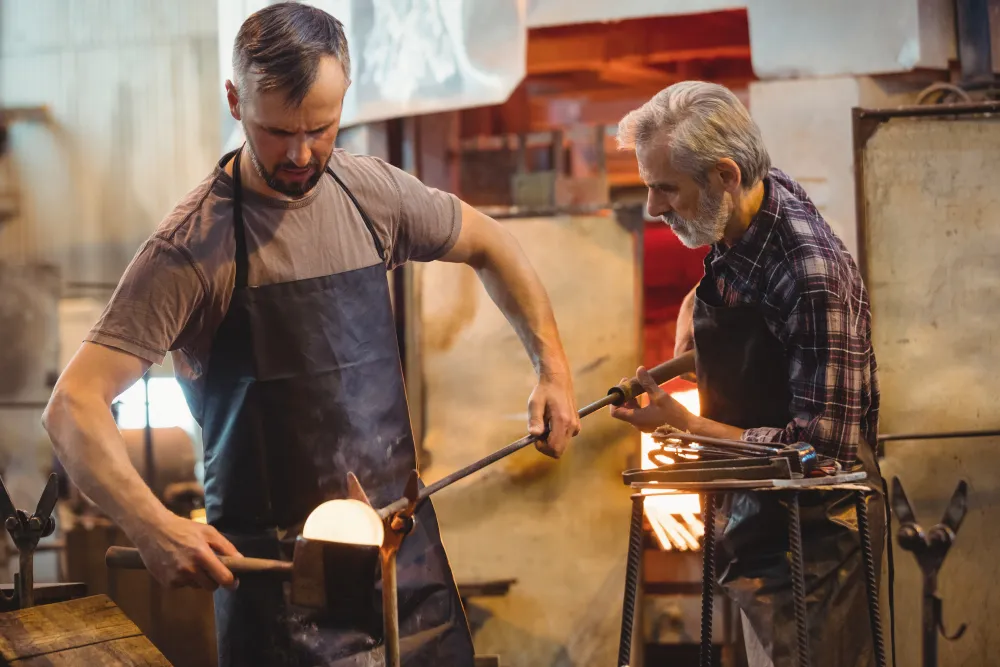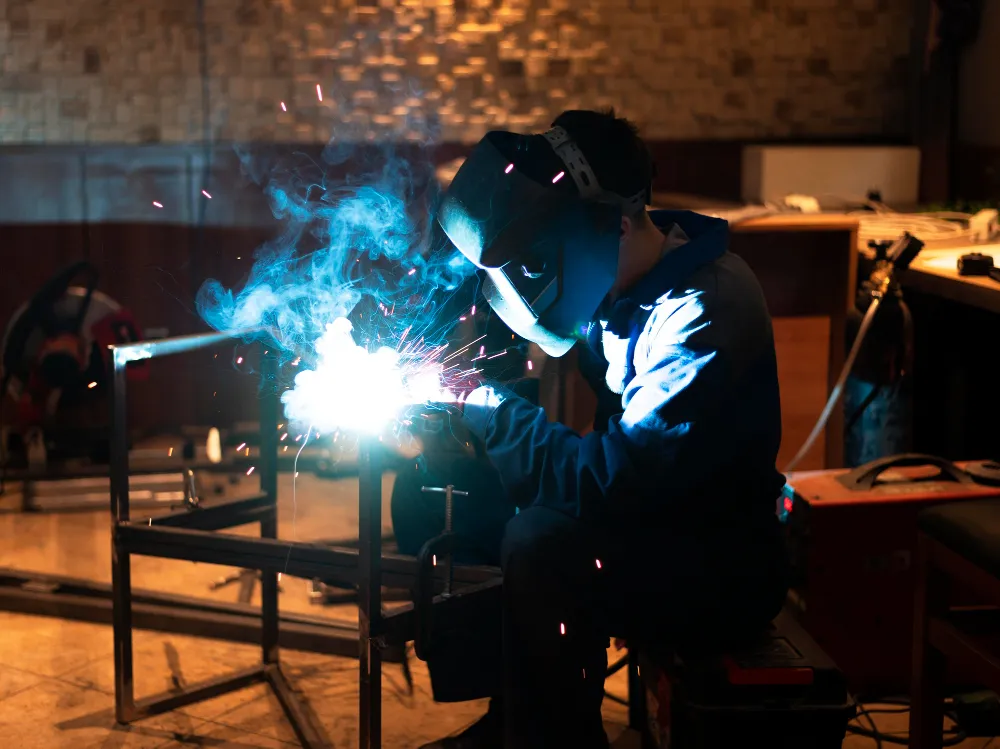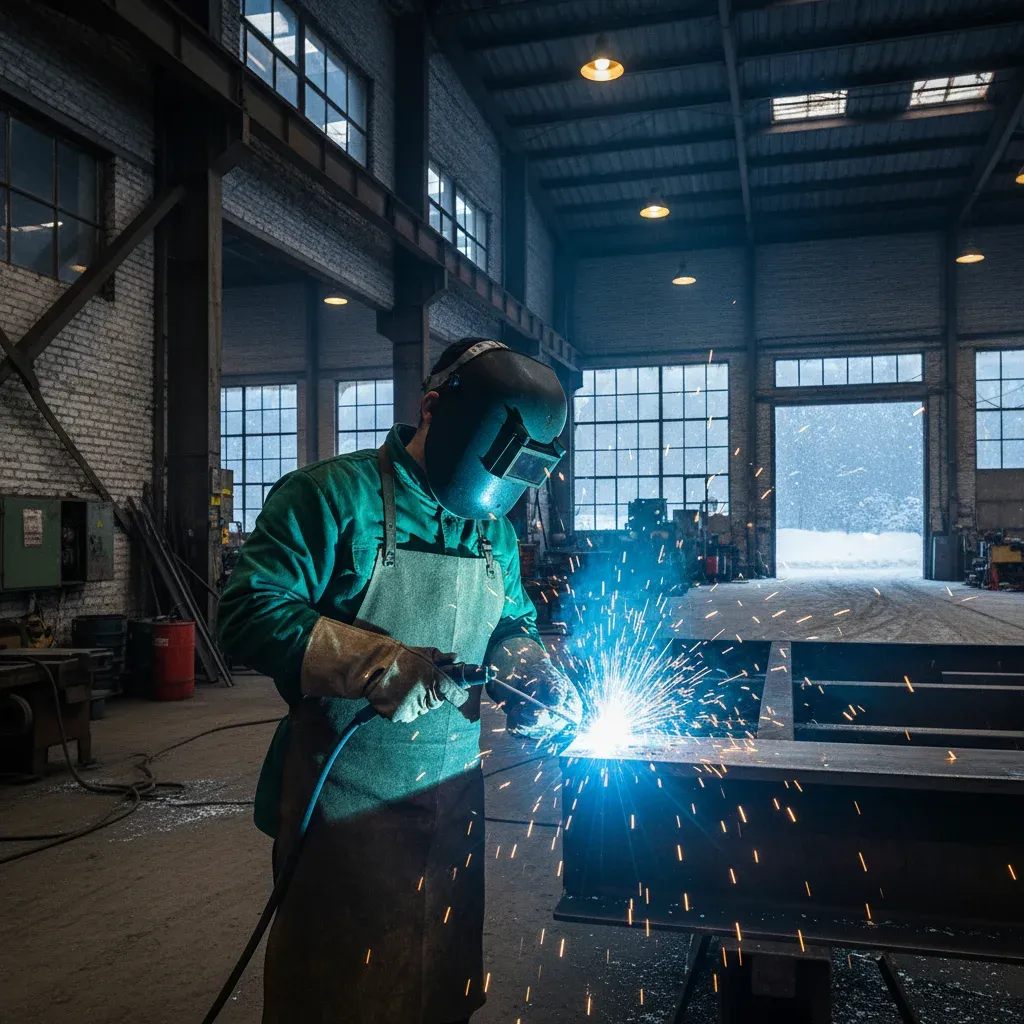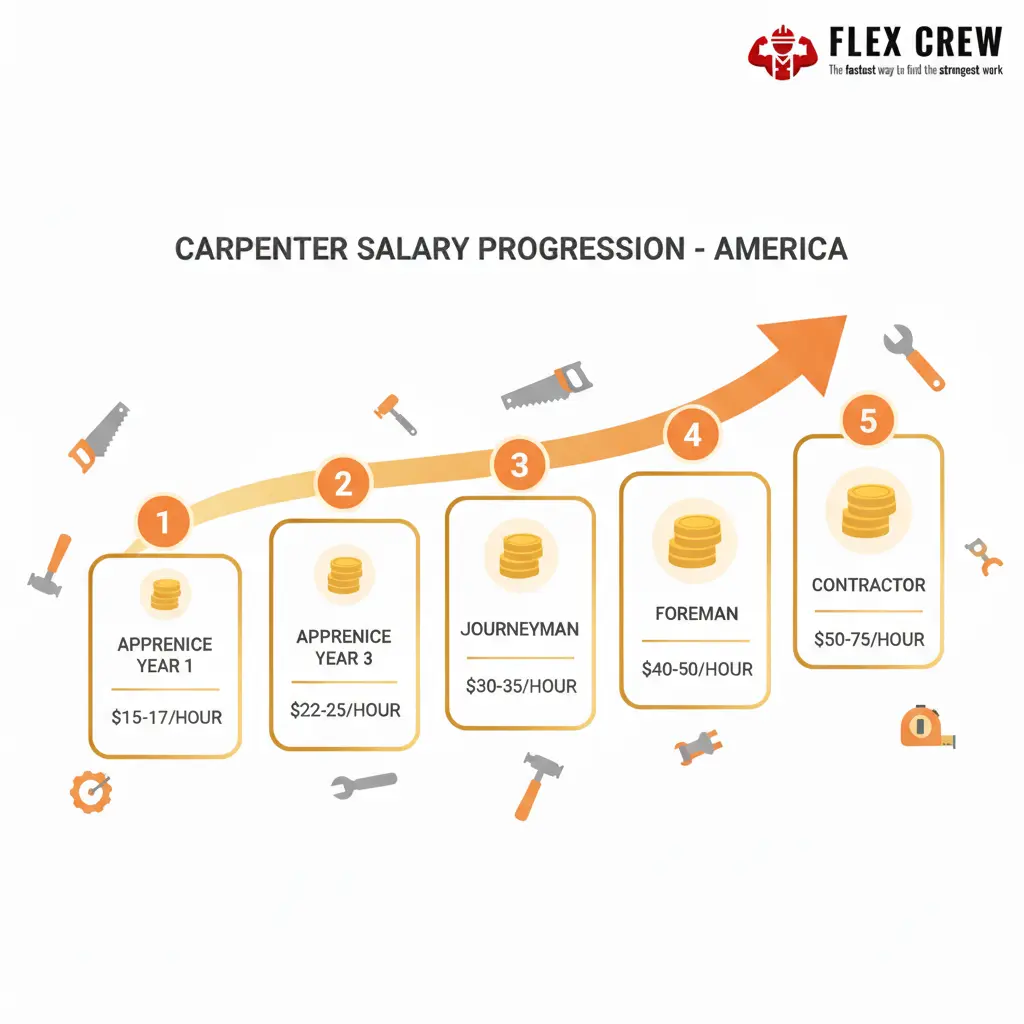The construction industry is experiencing an unprecedented boom, and skilled iron workers are in higher demand than ever before. From towering skyscrapers in New York to sprawling data centers in Texas, iron workers are the backbone of America's infrastructure development. With about 7,500 job openings projected each year and employment expected to grow 4 percent from 2023 to 2033, this skilled trade offers exceptional job security, competitive wages, and opportunities for career advancement that don't require a four-year college degree.
Bottom Line Up Front: Iron workers earn strong wages (typically $50,000-$70,000+ annually), enjoy excellent job security with growing demand, and can build rewarding careers through apprenticeship programs that pay while you learn. States like Texas, Florida, Ohio, and Georgia are experiencing particularly strong growth in construction activity, creating abundant opportunities for skilled iron workers.
What Do Iron Workers Actually Do?
Iron workersare the skilled craftspeople responsible for assembling the steel skeletons that support our modern world. They install structural and reinforcing iron and steel to form and support buildings, bridges, and roads. But the work goes far beyond just "putting steel together" – it requires precision, technical knowledge, and physical skill.

The Three Main Types of Iron Work
Structural Iron and Steel Workers are the high-rise heroes you see working on skyscrapers and large buildings. They erect, place, and join steel girders, columns, and other pieces to form structural frameworks. These professionals also assemble precut metal buildings and may work with cranes and derricks that move materials around construction sites.
Reinforcing Iron and Rebar Workers focus on strengthening concrete structures. They position and secure steel bars or mesh in concrete forms for purposes of reinforcement. Sometimes called "rod busters," these workers ensure that concrete structures can withstand tremendous loads and stresses.
Ornamental Iron Workers create the decorative and functional metalwork you see in buildings. They install metal-clad windows, curtain wall systems, stairways, railings, and building facades. This specialty combines structural knowledge with an eye for design and aesthetics.
Each type of iron work requires specific skills, but many iron workers develop expertise across multiple specialties throughout their careers, making them highly versatile and valuable to employers.
Show Me the Money: Iron Worker Salaries and Benefits
One of the most attractive aspects of an iron worker career is the earning potential. The average salary of an iron worker typically ranges from $50,000 to $70,000 per year in the United States, but this varies significantly based on experience, location, and specialization.
Breaking Down the Numbers
According to recent industry data, structural iron and steelworkers earned an average salary of $68,220 in 2023, while the average hourly pay for a structural iron worker is $24.71 in 2025. However, experienced iron workers in high-demand areas can earn significantly more.
Geographic Variations Matter: Location plays a huge role in determining your paycheck. Midwestern states offer the best cost-adjusted wages, with Illinois leading at over $79,000 annually, while Southern states rank consistently lower. For example, iron workers in California, Alaska, and Hawaii typically earn the highest nominal wages, while those in states like Texas, Florida, and Georgia may earn less per hour but benefit from lower living costs.
Union vs. Non-Union: Many iron workers belong to unions, particularly the International Association of Bridge, Structural, Ornamental and Reinforcing Iron Workers. Union iron workers can earn wages like $38.77/hr plus $17.62/hr in supplemental wages plus $4.16 into an annuity, along with comprehensive benefits packages including health insurance, retirement plans, and safety protections.
Career Progression and Earning Potential
Iron workers don't just start at the top – there's a clear progression path:
Apprentice Iron Workers typically start at about 50% of journeyman wages, gradually increasing as they gain skills and experience
Journeyman Iron Workers represent the standard skilled level, earning full wages
Foremen and Supervisors can advance to leadership roles with increased responsibilities and higher pay
Specialty Certifications in welding, rigging, or crane operation can command premium wages
Iron workers with more experience, training and certifications tend to have higher salaries, making continuous learning a direct path to better compensation.
How to Become an Iron Worker: Your Path to Success
The best part about pursuing an iron worker career? You don't need an expensive college degree, and you can earn while you learn. Most iron workers learn their trade through a 3- or 4-year apprenticeship, which combines paid on-the-job training with classroom instruction.
Apprenticeship Programs: Your Gateway In
For each year of the program, apprentices must have at least 144 hours of related technical instruction and 2,000 hours of paid on-the-job training. These programs are typically sponsored by unions and contractor associations, ensuring you receive comprehensive training that meets industry standards.
What You'll Learn:
Blueprint reading and sketching
Proper use of tools and equipment
Handling, measuring, cutting, and laying rebar
Constructing metal frameworks
Safety practices and first aid
Welding techniques
Rigging and signaling
OSHA compliance standards
Basic Requirements for Most Programs:
Must be at least 18 years old
High school diploma or GED
Physical ability to perform demanding work
Basic math and reading skills
Legal authorization to work in the U.S.
Alternative Training Paths
While apprenticeships are the gold standard, other paths exist:
Technical Schools offer iron worker programs that can provide foundational knowledge, though hands-on experience remains crucial.
Military Experience in construction, welding, or mechanical fields can provide transferable skills that make you an attractive apprentice candidate.
On-the-Job Training is sometimes available with employers willing to train motivated individuals, though this path typically takes longer to achieve full competency.

Where the Work Is: Geographic Opportunities
The construction industry isn't uniform across the country – some states are experiencing explosive growth while others see steadier, more moderate activity. Understanding these patterns can help you target the best opportunities.
High-Growth States for Iron Workers
Texas leads the nation in construction job growth, with surging demand for data centers, manufacturing plants, power projects and infrastructure. The state's business-friendly environment and population growth create consistent demand for skilled iron workers.
Florida continues to see strong construction activity driven by population migration and infrastructure needs. Multiple iron worker positions are available throughout the state, from Miami's high-rise boom to infrastructure projects across the peninsula.
Ohio offers solid opportunities, particularly in industrial construction. Major projects like the Micron facility in Columbus are creating immediate demand for iron workers with competitive wages and overtime opportunities.
Georgia rounds out the high-growth states with steady construction activity in both Atlanta's urban core and throughout the state's growing industrial corridor.
Understanding Regional Differences
While these states offer numerous opportunities, it's important to understand the trade-offs. Many of the states with the most construction jobs are not among the best-paying states. In fact, Texas, Florida, North Carolina, Arizona, Virginia and Michigan all pay an average wage that is below the national average. However, lower living costs in these areas can offset the wage differential.
Conversely, states like California, New York, and Illinois offer higher nominal wages but come with significantly higher living costs. The key is finding the right balance for your personal situation.
What to Expect: The Reality of Iron Worker Life
Iron work is rewarding but demanding. It's important to have realistic expectations about what the job entails daily.
The Physical Demands
Iron workers perform physically demanding and dangerous work, often at great heights. You'll spend much of your time moving, stooping, carrying, bending, cutting, and connecting iron or steel components. The work requires good physical condition, balance, and the ability to work comfortably at heights – sometimes hundreds of feet above ground.
Typical working conditions include:
Outdoor work in various weather conditions
Working at significant heights on skyscrapers, bridges, and towers
Operating heavy machinery and power tools
Lifting and positioning heavy steel components
Working as part of a coordinated team where timing matters
Safety: The Top Priority
Workers must wear safety equipment to reduce the risk of falls or other injuries. The construction industry has made tremendous strides in safety over recent decades, and reputable employers prioritize worker protection.
Standard safety equipment includes:
Safety harnesses and fall protection systems
Hard hats and safety glasses
Steel-toed boots with good grip
Protective gloves
High-visibility clothing
Union contractors invest millions of dollars annually to train their employees, and you are 10 times more likely to be killed on a non-union work site than a Union site. This highlights the importance of working with employers who prioritize safety training and proper equipment.
Work Schedule and Travel
Most iron workers work full-time schedules, often with opportunities for overtime that can significantly boost earnings. Projects might offer 5-8 hour days, or 5-10 hour days plus 8 on Saturday, with double time after 10 hours and on Sundays and holidays.
Travel considerations:
Major projects may require travel to different job sites
Some iron workers enjoy the variety of working in different cities and states
Per diem allowances often help offset travel expenses
Projects can last anywhere from weeks to years
Career Advancement and Specialization Opportunities
Iron work offers numerous paths for career growth and specialization. As you gain experience, multiple advancement opportunities become available.
Supervisory Roles
Experienced iron workers can advance to foreman positions, where they direct work crews, coordinate with other trades, and ensure projects meet specifications and safety standards. After gaining experience, iron workers may advance to become a supervisor or a manager, a position in which they have more responsibilities and are tasked with directing other iron workers.
Technical Specializations
Welding Certification opens doors to higher-paying specialized positions. Certifications in welding, rigging, and crane signaling may make iron workers more attractive to prospective employers.
Rigging and Crane Operation specialists focus on the complex task of moving heavy steel components safely and precisely.
Quality Control and Inspection roles involve ensuring that iron work meets engineering specifications and building codes.
Entrepreneurial Opportunities
Many experienced iron workers eventually start their own contracting companies, leveraging their skills, industry knowledge, and professional networks to build successful businesses.
How Staffing Agencies Like Flexcrew Can Help
Navigating the iron worker job market can be challenging, especially when you're starting out or looking to advance your career. This is where specialized construction staffing agencies become invaluable partners.
Flexcrew USA understands the iron worker trade and maintains relationships with contractors throughout Texas, Florida, Ohio, Georgia, and beyond. They can help match your skills and experience level with appropriate opportunities, whether you're seeking your first apprenticeship or looking for specialized project work.
Benefits of working with construction staffing agencies:
Access to job opportunities that might not be publicly advertised
Guidance on which certifications and skills are in highest demand
Assistance with resume and interview preparation specific to the construction industry
Connections with reputable contractors who prioritize safety and fair compensation
Support in finding positions that offer growth opportunities
For employers, agencies like Flexcrew provide access to pre-screened, qualified iron workers who understand the demands and safety requirements of the trade.
The Future Looks Bright for Iron Workers
The outlook for iron workers remains strongly positive. Steel and reinforced concrete are important parts of commercial and industrial buildings. Future construction of these structures is expected to require iron workers. The need to fix, maintain, or replace an increasing number of older highways and bridges also is expected to lead to employment growth.
Several trends are driving continued demand:
Infrastructure Investment: Aging bridges, highways, and public facilities across the country need repair and replacement, creating steady work for iron workers.
Data Centers and Technology: The digital economy requires massive data centers with complex steel frameworks, creating new opportunities for skilled iron workers.
Manufacturing Reshoring: Companies bringing production back to the United States are building new manufacturing facilities that require extensive structural steel work.
Green Energy Projects: Wind farms, solar installations, and battery storage facilities all require skilled iron workers for construction and maintenance.
Urban Development: Growing cities continue to need new high-rise buildings, requiring structural iron workers for construction.
Taking the Next Step
If you're considering a career as an iron worker, now is an excellent time to get started. The combination of strong demand, competitive wages, comprehensive training programs, and multiple career advancement paths makes iron work an attractive option for those seeking a skilled trade career.
Your next steps might include:
Research apprenticeship programs in your area or in states where you're willing to relocate
Connect with local iron worker unions to learn about application processes and requirements
Consider contacting construction staffing agencies like Flexcrew USA to discuss opportunities
Talk to working iron workers to get firsthand insights into the trade
Assess your physical readiness and comfort with heights
The construction industry needs skilled, dedicated iron workers who take pride in building America's infrastructure. With proper training, safety awareness, and a strong work ethic, an iron worker career can provide financial stability, job satisfaction, and the knowledge that your work literally supports the communities where people live and work.
Frequently Asked Questions About Iron Worker Careers
Q: How long does it take to become a fully qualified iron worker?
A: Most iron workers complete a 3-4 year apprenticeship program to become journeyman iron workers. During this time, you'll earn while you learn, starting at about 50% of journeyman wages and progressing to full pay upon completion.
Q: Do I need a college degree to become an iron worker?
A: No, you don't need a college degree. A high school diploma or GED is typically sufficient for apprenticeship programs. The focus is on hands-on training and developing practical skills rather than academic credentials.
Q: Is iron work dangerous, and what safety measures are in place?
A: While iron work involves inherent risks due to heights and heavy materials, modern safety protocols and equipment have significantly reduced accidents. Proper training, safety harnesses, and strict adherence to OSHA standards help protect workers.
Q: Can iron workers work year-round, or is it seasonal work?
A: Iron work availability can vary by region and weather conditions. Some outdoor structural work may be limited during extreme weather, but many projects continue year-round. Indoor work and shop fabrication provide more consistent schedules.
Q: What's the difference between union and non-union iron worker positions?
A: Union positions typically offer higher wages, better benefits, standardized training programs, and stronger safety protections. Non-union positions may offer more flexibility but potentially lower compensation and fewer protections.
Q: Are there opportunities for women in iron work?
A: Yes, though the field remains male-dominated, women are increasingly entering iron work trades. Many apprenticeship programs actively encourage diversity, and federal initiatives support women in construction careers.



